Eco-friendly silk tea bags are a sustainable and luxurious alternative you can make at home. You'll need organic silk fabric, food-safe thread, and basic sewing tools. Start by cutting silk into squares, sterilizing them, and sewing three sides to create a pouch. Add a drawstring or clasp for easy filling and cleaning. These reusable bags enhance your tea-drinking experience with better infusion and flavor while reducing environmental impact. Fill them with your favorite loose leaf teas or custom blends. With proper care, they'll last for many brews. Discover how to craft, maintain, and package these elegant tea bags for a greener cup of tea.
Benefits of Silk Tea Bags
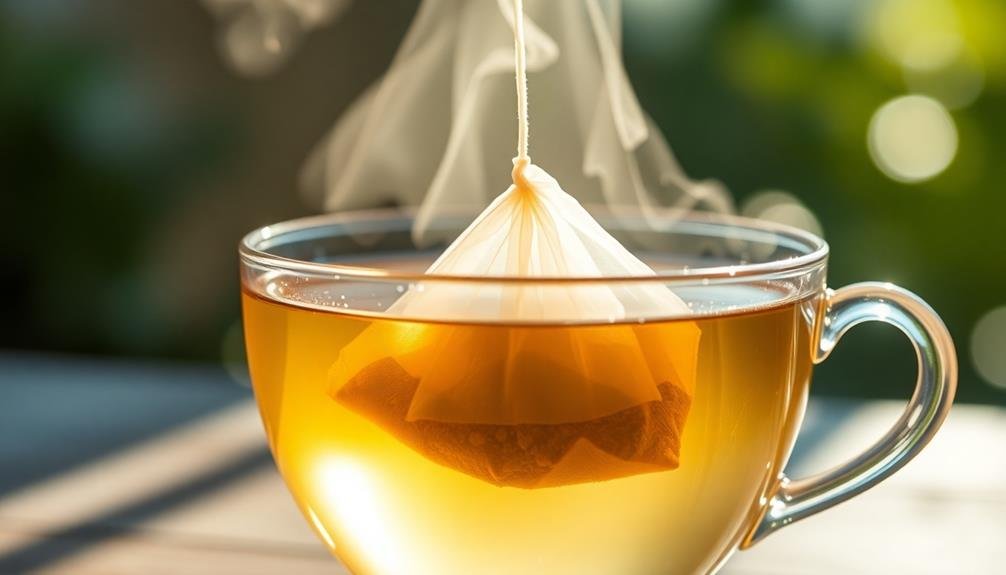
Silk tea bags offer numerous advantages over traditional paper options. They're biodegradable and compostable, breaking down naturally without leaving harmful microplastics behind.
You'll appreciate the silky smooth texture and elegant appearance, which can elevate your tea-drinking experience. These bags allow for better water flow, resulting in a more flavorful brew. The fine mesh structure permits ideal infusion while preventing tea leaves from escaping into your cup.
You'll notice a cleaner taste, as silk doesn't impart any unwanted flavors to your tea. Silk tea bags are also reusable, saving you money and reducing waste. Simply rinse them after use and let them dry for your next cup.
They're durable enough to withstand multiple uses without losing their integrity. Additionally, silk is a natural, renewable resource that's gentler on the environment than synthetic alternatives. By choosing silk tea bags, you're supporting sustainable practices and reducing your carbon footprint.
They're also free from harmful chemicals often found in bleached paper bags, making them a healthier choice for you and the planet.
Required Materials and Tools
To commence your eco-friendly silk tea bag journey, you'll need a few key materials and tools. First, source organic silk fabric, which forms the base of your tea bags. You'll also need organic cotton thread for sewing and food-grade string for the tea bag tags. Don't forget to obtain food-safe, non-toxic fabric dye if you want to add color to your bags.
For tools, gather sharp scissors for cutting fabric, a sewing machine or needle for stitching, and a small iron for pressing seams. You'll also need a ruler or measuring tape for precise dimensions. Consider having tweezers on hand for handling small pieces and a hole punch for creating tag holes.
To fill your tea bags, stock up on your favorite loose-leaf teas. You might want to invest in a small funnel to make filling easier.
Finally, prepare labels or tags for identifying different tea blends. These can be made from recycled paper or cardstock.
With these materials and tools ready, you're well-equipped to start creating your own eco-friendly silk tea bags, reducing waste and enhancing your tea-drinking experience.
Choosing Suitable Fabrics
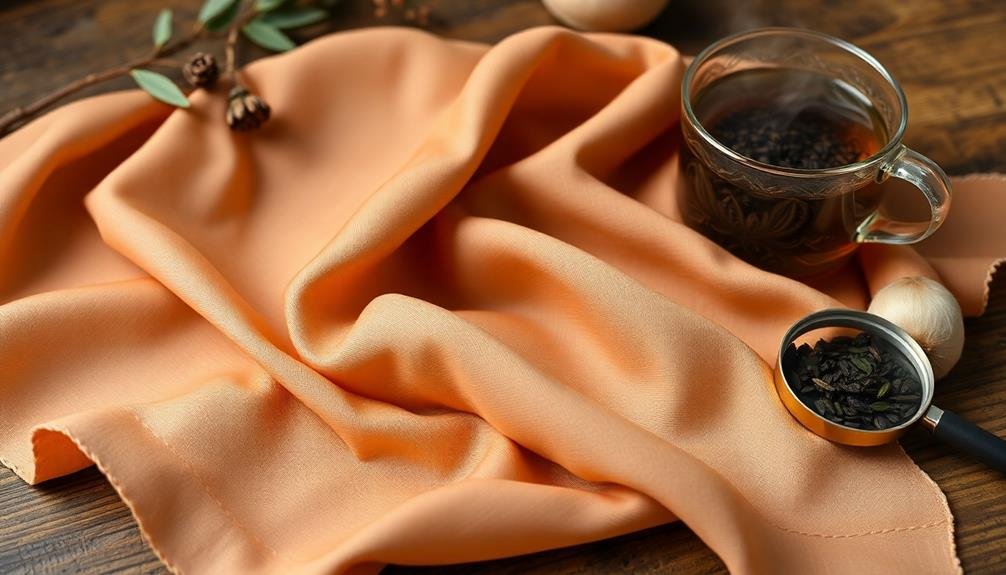
When selecting fabrics for your eco-friendly tea bags, you'll want to contemplate organic cotton options.
Cotton is biodegradable and chemical-free, making it an excellent choice for environmentally conscious tea drinkers.
If you're looking for alternatives, bamboo fabric offers similar benefits while being naturally antimicrobial and quick-drying.
Organic Cotton Options
Selecting organic cotton as an alternative to silk offers eco-conscious tea enthusiasts a sustainable option for their tea bags. You'll find that organic cotton is grown without harmful pesticides or synthetic fertilizers, making it an environmentally friendly choice.
When choosing organic cotton for your tea bags, look for GOTS (Global Organic Textile Standard) certified fabrics to guarantee the highest quality and ethical production standards.
Organic cotton tea bags are biodegradable and compostable, reducing your environmental impact. They're also durable enough to withstand hot water and multiple uses.
You can easily find organic cotton fabric in various weaves, such as muslin or cheesecloth, which work well for tea bags. These fabrics allow for proper infusion while keeping tea leaves contained.
To create your tea bags, cut the organic cotton fabric into small squares or circles, depending on your preferred shape. You can sew the edges or use food-safe glue to seal them.
Don't forget to attach a string for easy removal. By opting for organic cotton, you're making a conscious choice that benefits both your health and the planet.
Bamboo Fabric Alternatives
Numerous bamboo fabric alternatives offer excellent options for eco-friendly tea bags. You'll find that bamboo fabric is an increasingly popular choice due to its sustainability and versatility.
It's naturally antimicrobial, breathable, and biodegradable, making it ideal for tea bags.
When selecting bamboo fabric for your tea bags, opt for 100% bamboo viscose or lyocell. These materials are softer and more pliable than traditional cotton, allowing for better infusion of tea flavors.
You can easily find bamboo fabric in various weights and textures, so choose one that's thin enough for tea to seep through but sturdy enough to withstand hot water.
To create your bamboo tea bags, cut the fabric into small squares or circles, depending on your preferred shape. Sew the edges, leaving one side open for filling.
You can use a sewing machine or hand-stitch for a more rustic look. Remember to double-stitch the seams for added durability.
Once filled with your favorite loose tea, seal the final edge. You'll have eco-friendly, reusable tea bags that are gentle on the environment and enhance your tea-drinking experience.
Preparing the Silk Fabric
The preparation of silk fabric is an essential step in crafting eco-friendly tea bags. You'll need to start with a high-quality, pure silk fabric that's free from any chemical treatments or dyes. Choose a lightweight, breathable silk like habotai or chiffon for the best results.
Begin by washing the silk fabric in cool water with a mild, eco-friendly detergent to remove any impurities. Avoid using harsh soaps or fabric softeners, as these can affect the silk's natural properties. Rinse the fabric thoroughly and allow it to air dry completely.
Once dry, iron the silk on a low heat setting to remove any wrinkles. Be careful not to scorch the delicate fabric.
Next, cut the silk into squares or circles, depending on your preferred tea bag shape. You'll want to make them slightly larger than your desired final size to allow for seams.
To guarantee your silk tea bags are food-safe, you can sterilize the cut pieces by boiling them in water for a few minutes. After boiling, let them dry completely before proceeding with assembly.
Crafting the Tea Bag Shape
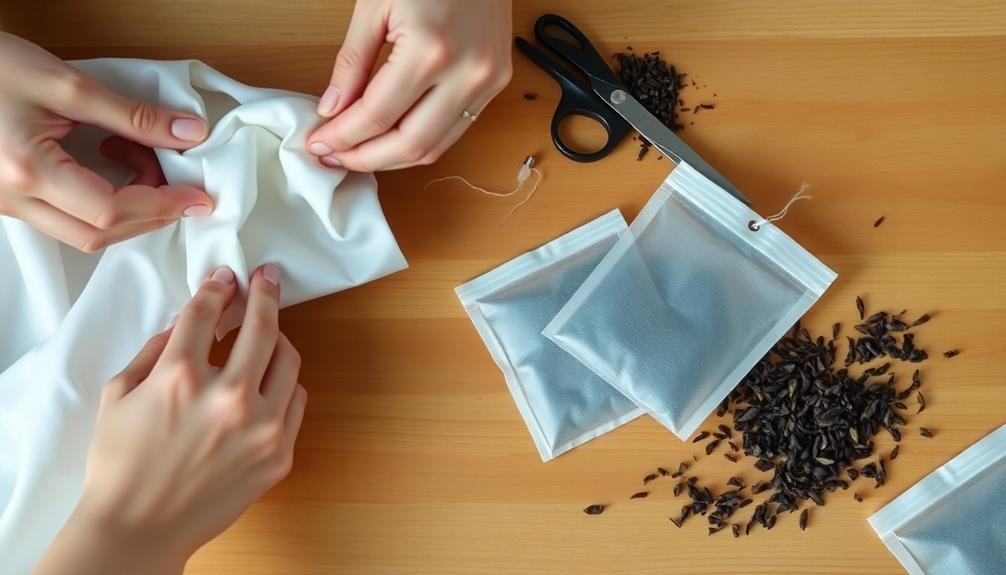
Crafting the perfect tea bag shape is essential for functionality and aesthetics. You'll want to create a design that allows for ideal tea infusion while maintaining a sleek appearance.
Start by folding your prepared silk fabric in half, creating a rectangle. Use sharp scissors to round off the corners, giving your tea bag a softer look.
Next, you'll need to sew three sides of the rectangle, leaving one short end open. Turn the bag inside out through the open end, ensuring the seams are neat. For added strength, you can double-stitch the seams.
Now, it's time to add a string for easy removal from your cup. Cut a piece of organic cotton string about 6 inches long and attach it securely to the open end of the bag.
To finish, fold the open end inward and sew it closed, encasing the string's end. You can experiment with different shapes, such as pyramids or circles, by adjusting your initial fabric cut and folding techniques.
Remember to leave enough room for your tea leaves to expand during steeping.
Sewing Techniques for Durability
Ensuring your eco-friendly silk tea bags can withstand repeated use requires robust sewing techniques. You'll want to focus on creating strong seams that won't unravel or tear during steeping. Start by using a fine needle and silk thread that matches your fabric color. Double-stitch the edges of your tea bag for extra durability, and reinforce the corners where stress is greatest.
Consider these key sewing techniques for long-lasting silk tea bags:
- French seams: Hide raw edges and create a neat, strong finish
- Overlocking: Prevent fraying and add strength to the edges
- Zigzag stitching: Provide flexibility and prevent tearing
- Bar tacking: Reinforce high-stress areas like corners and openings
When sewing the top of your tea bag, create a small channel to thread your string or chain through. This allows for easy removal and replacement of the string if needed.
If you're adding a tag, securely attach it to the string using a small knot or stitch. Remember to trim any loose threads carefully to prevent them from floating in your tea.
With these techniques, you'll create durable silk tea bags that are both eco-friendly and long-lasting.
Adding Drawstrings or Clasps
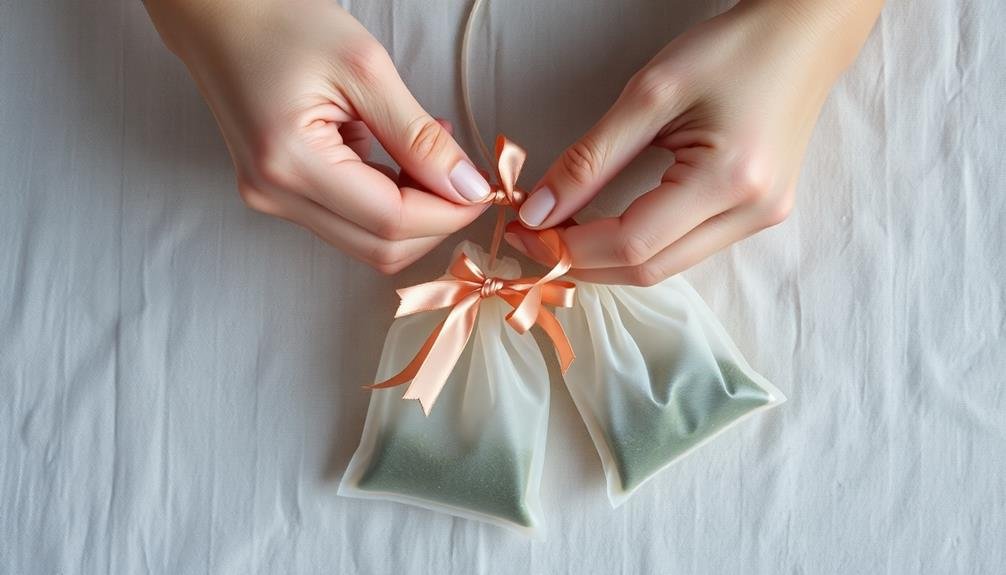
Many eco-friendly silk tea bags benefit from the addition of drawstrings or clasps for easy sealing and reuse.
You'll find that these features not only enhance the functionality of your tea bags but also extend their lifespan.
For drawstrings, you can use thin silk ribbons or cotton cords.
Thread them through small holes or a channel sewn along the top edge of the bag.
Make certain the drawstring is long enough to tie securely.
You can add decorative beads or knots at the ends for a charming touch.
Clasps offer another practical option.
Small metal snaps or buttons work well for this purpose.
Sew one part of the clasp to the front of the bag and the other to the back flap.
This allows for quick and easy opening and closing.
If you prefer a more natural look, consider using wooden toggles or coconut shell buttons.
These eco-friendly options complement the silk material beautifully.
You can even create loops from the silk fabric itself to serve as closures, eliminating the need for additional materials.
Proper Tea Bag Care
To keep your eco-friendly silk tea bags in top condition, you'll need to follow proper care instructions.
After use, rinse your silk tea bag with cool water and gently squeeze out excess moisture before hanging it to dry completely.
Store your clean, dry tea bags in an airtight container away from direct sunlight and strong odors to maintain their quality and extend their lifespan.
Cleaning and Storage Tips
With proper care, your eco-friendly silk tea bags can last for multiple uses.
After brewing, gently rinse the bag with cool water to remove any remaining tea particles. Avoid using soap, as it can leave residues that affect the taste of future brews. Squeeze out excess water and hang the bag to air dry completely before storing.
Store your clean, dry silk tea bags in an airtight container in a cool, dry place. This prevents moisture and odors from affecting the bags and preserves their quality. If you're reusing a bag soon, you can keep it in a small dish or saucer in the refrigerator for up to 24 hours.
To maintain the longevity of your silk tea bags:
- Avoid exposing them to direct sunlight
- Don't use harsh chemicals or bleach for cleaning
- Replace bags if you notice any signs of wear or tear
- Rotate your tea bags to guarantee even use
Extending Tea Bag Lifespan
Proper care is the key to extending the lifespan of your eco-friendly silk tea bags. After each use, gently rinse the bag with cool water to remove any tea residue. Avoid using hot water, as it can damage the delicate silk fibers. Once rinsed, carefully squeeze out excess water without twisting or wringing the bag.
To dry your silk tea bags, lay them flat on a clean towel or hang them in a well-ventilated area. Make certain they're completely dry before storing to prevent mold growth. When storing, keep them in an airtight container away from direct sunlight and strong odors.
You can reuse silk tea bags multiple times, but be mindful of their condition. Inspect them regularly for signs of wear or damage. If you notice any fraying or holes, it's time to replace the bag.
To maximize their lifespan, alternate between different bags rather than using the same one repeatedly. Consider using a tea infuser or strainer occasionally to give your silk bags a break. This rotation will help preserve their integrity and extend their overall lifespan.
With proper care, your eco-friendly silk tea bags can last for months, reducing waste and enhancing your tea-drinking experience.
Filling With Custom Tea Blends
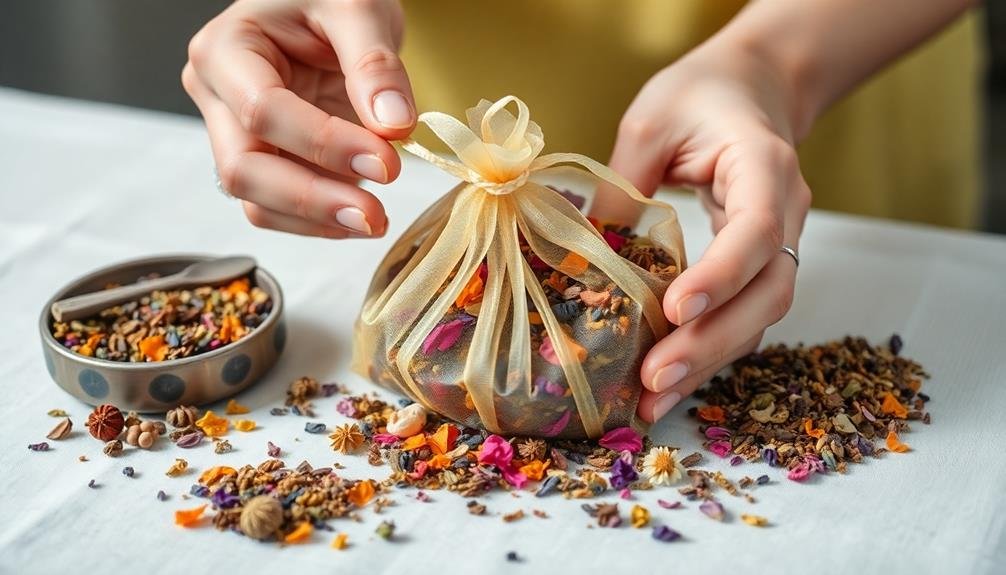
After creating your eco-friendly silk tea bags, it's time to fill them with your favorite custom tea blends. Experiment with different combinations of loose-leaf teas, herbs, and spices to create unique flavors tailored to your taste preferences.
Start by selecting a base tea, such as black, green, or white, and then add complementary ingredients to enhance the flavor profile.
Consider these popular additions to your custom tea blends:
- Dried fruits like apple, lemon, or berries for a fruity twist
- Herbs such as mint, lavender, or chamomile for a soothing effect
- Spices like cinnamon, ginger, or cardamom for warmth and depth
- Flower petals like rose or jasmine for a floral aroma
When filling your silk tea bags, use about 1-2 teaspoons of your custom blend per bag, depending on the desired strength.
Be sure to leave enough space for the tea to expand when steeping. Seal the bags carefully to prevent any loose particles from escaping.
Label your custom blends with their ingredients and suggested steeping times for easy reference.
You'll enjoy the satisfaction of sipping your personalized tea creations while knowing you're using eco-friendly packaging.
Eco-Friendly Packaging Ideas
How can you present your eco-friendly silk tea bags in an equally sustainable manner? Consider using recycled paper boxes or tins for packaging. These materials are biodegradable and can be easily recycled again.
You can also opt for reusable glass jars or metal containers, which customers can repurpose after using the tea.
For individual tea bag wrappers, choose compostable paper or plant-based cellophane. These materials protect the tea while minimizing environmental impact.
You might also explore innovative options like seed paper, which can be planted after use to grow herbs or flowers.
Don't forget about labeling. Use soy-based inks and recycled paper labels to maintain your eco-friendly approach.
Consider minimalist designs that require less ink and packaging material.
For shipping, choose boxes made from recycled cardboard and use paper tape instead of plastic.
Fill empty spaces with biodegradable packing peanuts or shredded paper.
You can also encourage customers to return packaging for reuse by offering incentives like discounts on future purchases.
Frequently Asked Questions
Can Silk Tea Bags Be Used for Cold Brew Teas?
Yes, you can use silk tea bags for cold brew teas. They're perfect for this method as they allow for slow infusion and don't release any unwanted flavors. You'll get a smooth, cool cold brew with silk bags.
How Long Do Homemade Silk Tea Bags Typically Last?
You'll find that homemade silk tea bags typically last 1-2 months when stored properly. Keep them in an airtight container in a cool, dry place. They'll stay fresh longer if you avoid moisture and sunlight exposure.
Are There Any Teas That Shouldn't Be Used With Silk Bags?
You shouldn't use silk bags for finely ground teas like matcha or rooibos, as they'll seep through. Also, avoid strong-flavored teas like lapsang souchong, which can leave residual taste. Stick to whole leaf teas for best results.
Can Silk Tea Bags Be Composted After Use?
Yes, you can compost silk tea bags after use. They're biodegradable and will break down naturally in your compost bin. Just remove any staples or tags first. You'll be reducing waste and enriching your garden soil simultaneously.
Are There Any Health Concerns Associated With Using Silk Tea Bags?
You shouldn't worry too much about health concerns with silk tea bags. They're generally safe to use. However, if you've got silk allergies, you'll want to avoid them. Always check the packaging for any additives or treatments.
In Summary
You've now learned how to craft your own eco-friendly silk tea bags. They're not only beautiful but also reusable and gentle on the environment. By making these yourself, you'll reduce waste and enjoy a more luxurious tea experience. Don't forget to experiment with different fabrics, shapes, and tea blends. With proper care, your handmade silk tea bags will last for years. So go ahead, sip your tea in style, and feel good about your sustainable choice.





Leave a Reply